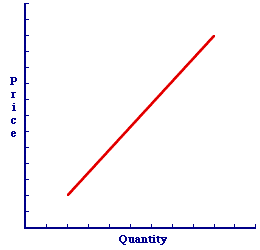
|
|
AMERICAN STOCK EXCHANGE: One of three national stock markets in the United States (see National Association of Securities Dealers and New York Stock Exchange) that trade ownership shares in corporations. In terms of daily stock transactions and the number of stocks listed, the American Stock Exchange is the smallest of these three. However, it's composite index of stock prices -- AMEX is considered important enough to be flashed briefly on the nightly news.
Visit the GLOSS*arama
|
|


|

|
                           COMPLEMENT-IN-PRODUCTION: One of two (or more) goods that are simultaneously produced using a given resource. A complement-in-production is one of two alternatives falling within the other prices determinant of supply. The other is a substitute-in-production. An increase in the price of one complement good causes an increase in supply for the other. Complements-in-production are two or more goods that are jointly produced using a given resource. The production of one good automatically triggers the production of another, often as a bi-product. Both goods are simultaneously produced from the same resource. The production of one good does not exclude the production of the other, as would be the case for substitutes-in-production. In fact, it promotes the production of the other. Produce one, produce both.Agricultural producers frequently generate bi-products when they produce a primary good, such as wheat and hay. Cattle ranchers produce both beef and leather from the same cattle resource. Lumber mills use timber resources to the produce two-by-fours and sawdust. The price of a complement-in-production is part of the other prices supply determinant. A change in the price of a complement-in-production causes a change in supply and a shift of the supply curve. An increase in the price of one complement good causes an increase in the supply of the other. A decrease in the price of one complement good causes a decrease in the supply of the other. Shifting the Supply CurveTo illustrate this process consider the simultaneous production of two goods--beef and leather. Each is jointly produced using the same cattle resources. When producers produce one, they produce both.Complement-in-Production
Leather | 
|
How is the supply of leather affected if the price of beef should change?- A Higher Price: Suppose the price of beef increases. Profit-minded cattle ranchers undoubtedly react according to the law of supply and increase the quantity supplied of beef. However, in that this generates leather as a bi-product, more leather is automatically produced. The result is an increase in the supply of leather and a rightward shift of the supply curve. Click the [Price Increase] button to demonstrate.
- A Lower Price: Suppose the price of beef decreases. Profit-minded cattle ranchers also likely react according to the law of supply and decrease the quantity supplied of beef. However, now there is less leather generated as a bi-product, with less leather automatically produced. The result is a decrease in the supply of leather and a leftward shift of the supply curve. Click the [Price Decrease] button to demonstrate.

Recommended Citation:COMPLEMENT-IN-PRODUCTION, AmosWEB Encyclonomic WEB*pedia, http://www.AmosWEB.com, AmosWEB LLC, 2000-2025. [Accessed: July 18, 2025].
Check Out These Related Terms... | | | | | | | |
Or For A Little Background... | | | | | | | | | |
And For Further Study... | | | | | | | | |
Search Again?
Back to the WEB*pedia
|



|

|
BLACK DISMALAPOD
[What's This?]
Today, you are likely to spend a great deal of time browsing about a thrift store seeking to buy either a genuine fake plastic Tiffany lamp or a microwave over that won't burn your popcorn. Be on the lookout for small children selling products door-to-door.
Your Complete Scope
This isn't me! What am I?
|

|
|
Mark Twain said "I wonder how much it would take to buy soap buble if there was only one in the world."
|

|
|
"A winner is someone who recognizes his God-given talents, works his tail off to develop them into skills, and uses those skills to accomplish his goals. " -- Larry Bird, basketball player
|

|
FAMS
Forecasting and Modeling System
|

|
|
Tell us what you think about AmosWEB. Like what you see? Have suggestions for improvements? Let us know. Click the User Feedback link.
User Feedback
|


|


